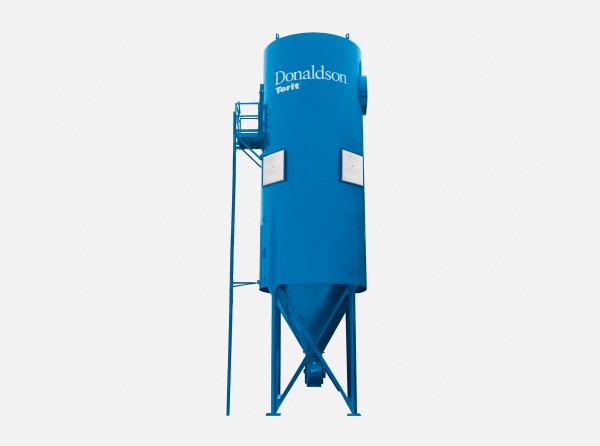A baghouse is a dust collector that uses fabric filter bags or pleated filters mounted within a sheet metal housing to remove the pollutants created during industrial processes from the air. Baghouses are one of the most widely used dust collection systems as they are both cost-effective and efficient.
A baghouse works as an air pollution control device, capturing harmful particulates and dust from an industrial environment and exhausting clean air.
While baghouse dust collectors vary in size, capacity and design depending on an industrial setting's needs and usage, they share some of the same components. Most baghouse systems have:
- Collection hoods and pickup points to capture dust
- Ductwork to transport the dust to the collector
- Felt or pleated filters that separate and collect dust from the air stream
- Fans or motors to draw dust laden air to the collector
- Dust container or device to collect and dispose of captured dust

How do Baghouses Work?
Most baghouses work by having a fan or blower that pulls dust laden air into the collector. The dust laden airstream is then separated by the baghouse filters, which collects dust on the surface of the filter while allowing clean air to pass through and out of the collector.
Baghouses are available in many shapes and sizes. Depending on the process needs and filter type, baghouses can use a single bag to hundreds or even thousands of felt or pleated filter bags.
A wide range of filter medias and types are available to meet the wide range of particulate and application characteristics of process owners. For example, oily dust often requires filters with an oleophobic treatment to handle the dust effectively, while the presence of moisture might require polypropylene, or Polytetrafluoroethylene (PTFE) treated filters. Pleated filters also offer higher filtration efficiencies and abrasion resistance.
How Are Baghouses Cleaned?
Baghouses also use a variety of methods to clean the felt or pleated filters, which is done to extend the life of a filter and keep the baghouse operating efficiently. Mechanical shaking, reverse air pressure, medium pressure and compressed air pulse jet are all different types of filter cleaning methods used to remove the dust from filters. Each method has advantages and disadvantages and are utilized by different types of baghouse collectors.
The baghouse filter cleaning methods are:
Reverse Air Baghouse: Reverse air baghouse filters are most commonly installed from the clean air side of the dust collector and are secured to the tubesheet, which is the divider between the clean air and dirty air plenums of the dust collector. Once installed, the filter body is suspended in the dirty air plenum of the collector and is ready to collect dust. During operation, dust-laden air flows through the baghouse and collects on the outside of the filter bags. To clean the filters, a fan or blower is utilized to generate a stream of clean air. The air stream is directed into the opening of the clean side of the filters by using a rotating arm. The airstream from the fan reverses the flow of air in the filter momentarily, and the backpressure of air causes the dust cake to break apart and fall into the hopper. Reverse air baghouses often clean continuously during operation to ensure optimal performance of the baghouse and filters. The high-volume and low-pressure filter cleaning of reverse air baghouses tend to be gentler on the bags, decreasing wear and tear. However, they can require more maintenance and the operating cost is often higher due to the energy required by the reverse air blower.
Medium-Pressure Baghouse: Medium-pressure baghouses use a medium-pressure, medium-volume pulse of clean air to remove dust cakes from loaded filters. Like reverse air baghouses, filters are typically installed from the clean air side of the baghouse and are secured to the tubesheet with the filter body suspended within the dirty air plenum. A positive displacement (PD) pump is used to pump air into a reservoir tank, and a rotating arm delivers pulses of medium-pressure, medium-volume air into filters at intervals controlled by a timer board. The pulse of air into the filters reverses airflow like the reverse air baghouse, causing dust cakes to be dislodged and the filter to be cleaned. The pulse signature, or impulse generated by the cleaning system on the filter, of a medium-pressure baghouse is typically stronger and more effective at cleaning filters than the reverse air baghouse. The PD pump motor also tends to be much smaller than a reverse air blower which results in energy savings. The combination of a standalone cleaning system, pulse signature and energy efficiency make medium-pressure baghouses a popular baghouse choice in a wide range of industries.
Pulse Jet Baghouses: Also known as a reverse-pulse baghouse, the pulse jet dust collector uses pulses of compressed air to clean dirty filters. Like other baghouses, dust contaminated air enters into the collector and is captured by filters. To clean pulse jet collectors, pulses of compressed air are directed through blowpipes that are mounted above each of the filter rows and into the clean side of the filters. This dislodges the dust cake which drops into the hopper, located at the bottom of the collector for removal. The pulse signature or impulse of compressed air is stronger than medium-pressure or reverse air baghouses, meaning that the cleaning system is more effective at cleaning off dust from filters than the other cleaning system types. Pulse jet cleaning can be costly to generate and route clean and dry compressed air to the collector from the facility. Large baghouses also require high volumes of compressed air contributing to a higher operational cost.
Mechanical Shaker Baghouses: Mechanical shaker baghouses are different than the other baghouses as they do not use air to clean the filters. Filters are attached to a tubesheet similar to other baghouses, and dust is collected on the surface of the filter media as air passes through. Dust can be collected on either the outside or inside of the filter depending on the configuration of the baghouse collector. To clean the filters, the baghouse system is shut down and the baghouse filters are cleaned by mechanically shaking out the bags. Shaking can be done manually on smaller collectors, while motors are commonly used for larger baghouses. The shaking releases the dust cake which falls into a hopper or dust collection device. Mechanical shaking is typically used in intermittent duty applications where processes only run for a shorter period of time before shutting down. Shaker cleaning is a cost-effective solution for these applications since pulse jet, medium-pressure and reverse air baghouses all require higher capital and operating costs to clean filters. However, shaker cleaning tends to be less effective at removing dust cakes and cleaning filters than other types of baghouses.

What Affects Baghouse Performance?
Some factors that will impact how a baghouse performs:
Baghouse Size: Not using the right size dust collector for the application and process can cause increased wear on filters. Baghouses that are sized too small, have too little filters or filter media can lead to inadequate capture velocities and airflow, short filter life, poor venting, damaged equipment, higher emissions, and a potentially dangerous work environment.
Filter Media: A wide range of baghouse filter medias are available for the wide range of applications and dust characteristics that exist in industrial processes. Filter media works differently depending on the environment, so it is essential to choose the correct filter media that meets the needs of the dust and process. Using the wrong filter fabric can reduce the lifespan of the filter and lead to a higher pressure drop, which can increase energy and operational costs and cause filters to fail.
Cleaning Type: The configuration and cleaning type of a baghouse also has a significant influence on its performance. Each type — reverse air, medium-pressure, pulse jet and mechanical — has pros and cons and selecting the right type of cleaning system for the application can improve performance, extend filter life and reduce operations costs.




